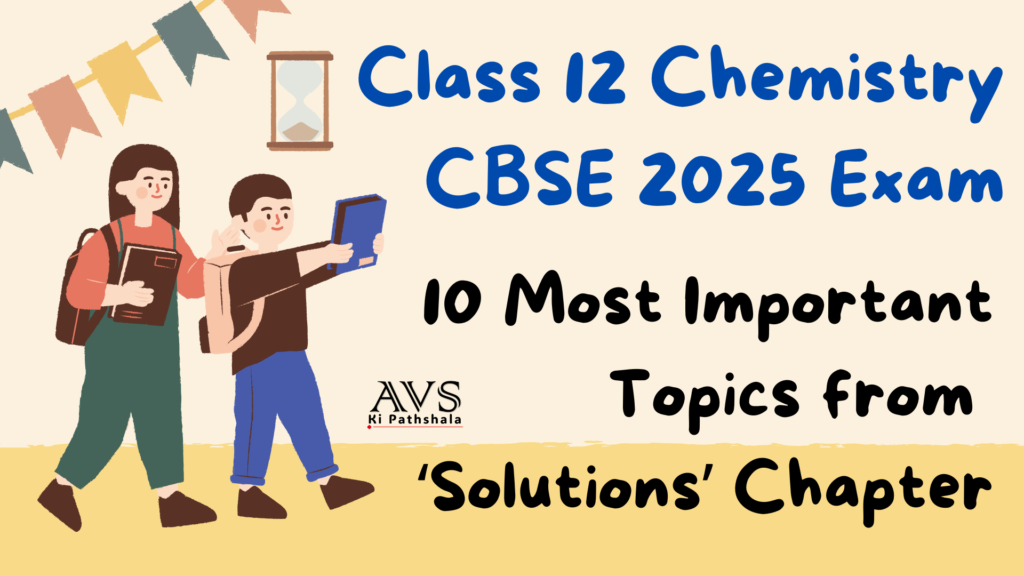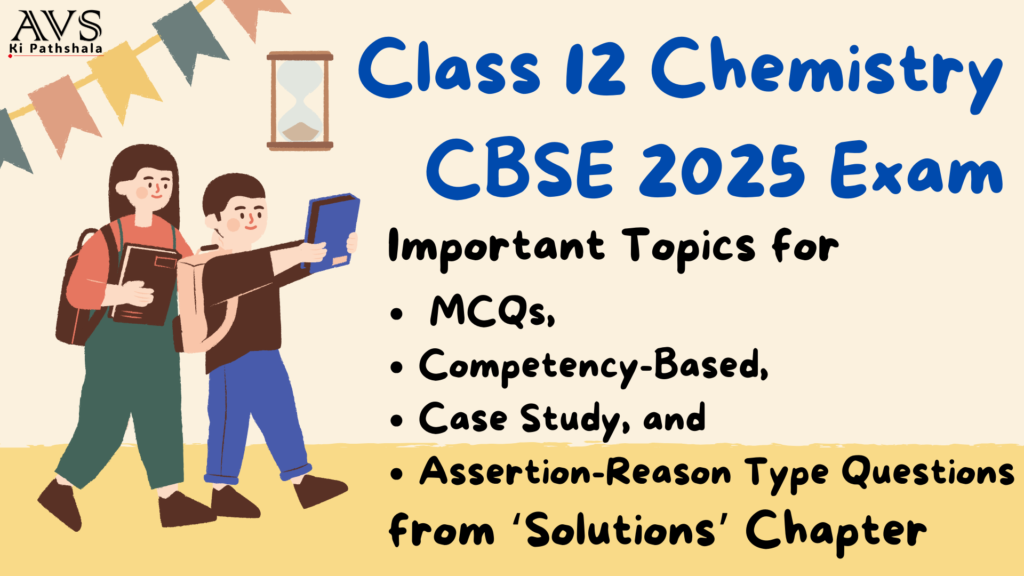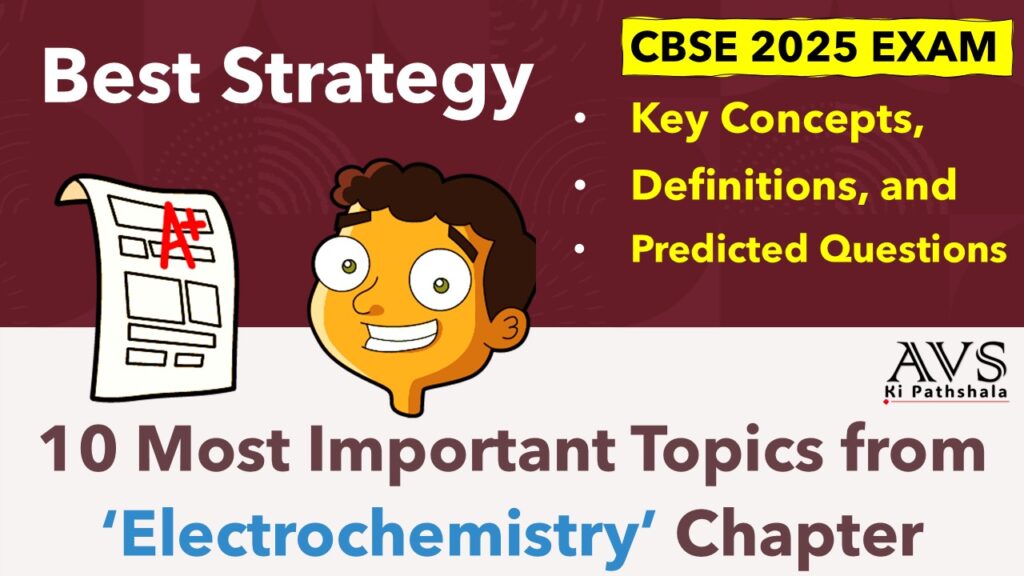Haloalkanes & Haloarenes
The chapter “Haloalkanes and Haloarenes” is a vital part of the CBSE Class 12 Chemistry syllabus, contributing significantly to board exam questions. Haloalkanes and Haloarenes chapter introduces students to the structure, nomenclature, physical properties, and chemical reactions of haloalkanes and haloarenes, along with their applications in the pharmaceutical and industrial sectors. For the 2025 board exams, it is essential to focus on key topics that are most likely to be asked based on previous years’ question patterns. In this guide, we present the top 10 most important topics that you must prioritize for optimal preparation.
Top 10 Important Topics for 2025 CBSE Board Exam Class 12 Chemistry
1. Nomenclature of Haloalkanes and Haloarenes
- Type of Question: Short Answer (2 marks)
- Explanation: Students are frequently asked to write IUPAC names or common names of simple haloalkanes and haloarenes.
- Example: CH3-CH2-Br → Bromoethane
C6H5-Cl → Chlorobenzene - Tip: Pay attention to the position and naming of substituents in more complex molecules.
2. Classification of Haloalkanes
- Type of Question: Short Answer (1-2 marks)
- Explanation: Classify haloalkanes into primary, secondary, and tertiary based on the number of carbon atoms attached to the carbon with the halogen.
- Example:
Primary Haloalkane: CH3CH2Cl (Ethyl chloride)
Secondary Haloalkane: CH3CHClCH3 (Isopropyl chloride)
3. Nature of C-X Bond
- Type of Question: Conceptual Short Answer (2 marks)
- Explanation: The C-X bond is polar due to the difference in electronegativity between carbon and the halogen (X). Discuss bond length and bond strength.
- Important Formula:
Dipole moment (μ) = q × r
where q = charge, r = bond length.
4. Mechanism of Nucleophilic Substitution Reactions (SN1 and SN2)
- Type of Question: Long Answer (3-5 marks)
- Explanation: The SN1 mechanism involves two steps, and the SN2 mechanism is a one-step process. Questions may ask for the distinction between them, factors affecting the mechanisms, or the reaction pathway.
- Key Difference:
- SN1: Favors tertiary haloalkanes. Two-step mechanism.
- SN2: Favors primary haloalkanes. One-step mechanism.
5. Stereochemical Aspects of Nucleophilic Substitution Reactions
- Type of Question: Long Answer (3 marks)
- Explanation: Focus on inversion of configuration (Walden inversion) in SN2 reactions and racemization in SN1 reactions.
- Important Point:
SN2 reaction leads to complete inversion of configuration (e.g., R → S or S → R).
6. Elimination Reactions (E1 and E2)
- Type of Question: Conceptual Long Answer (3-4 marks)
- Explanation: Compare the E1 and E2 mechanisms and explain how dehydrohalogenation leads to the formation of alkenes.
- Key Reaction:
CH3CH2Br + KOH (alcoholic) → CH2=CH2 + HBr
(Dehydrohalogenation)
7. Physical Properties of Haloalkanes and Haloarenes
- Type of Question: Short Answer (2 marks)
- Explanation: Explain boiling points, solubility, and density in relation to molecular weight and halogen size.
- Key Points:
- Higher the molecular weight, higher the boiling point.
- Haloarenes are less soluble in water due to non-polar C-H bonds.
8. Reaction of Haloalkanes with Metals (Wurtz and Fittig Reaction)
- Type of Question: Long Answer (3 marks)
- Explanation: The Wurtz reaction (for haloalkanes) and Fittig reaction (for haloarenes) are commonly asked in exams, where students are asked to explain the mechanism or provide examples.
- Example:
2CH3Br + 2Na → CH3CH3 + 2NaBr (Wurtz reaction)
9. Electrophilic Substitution Reactions in Haloarenes
- Type of Question: Long Answer (3-5 marks)
- Explanation: Explain the effects of halogen substitution on electrophilic aromatic substitution (EAS) reactions, such as nitration, halogenation, and sulphonation.
- Key Reaction:
C6H5Cl + HNO3 → C6H4Cl(NO2) + H2O (Nitration of chlorobenzene)
10. Environmental Effects of Haloalkanes and Haloarenes
- Type of Question: Short Answer (2 marks)
- Explanation: Haloalkanes and haloarenes, especially chlorofluorocarbons (CFCs), contribute to ozone layer depletion. Questions may ask for the environmental impact of such compounds.
- Key Point:
CFCs → Ozone Depletion → UV radiation exposure increases.
Important Topics for Different Question Types: CBSE Class 12 Chemistry
To help you excel in all types of questions — MCQs, competency-based questions, case study-based questions, and assertion-reason questions — here’s a breakdown of key topics from the “Haloalkanes and Haloarenes” chapter, classified according to the question type.
1. Multiple-Choice Questions (MCQs)
MCQs often focus on definitions, simple concepts, and direct application of formulas.
Important Topics:
- Nomenclature of Haloalkanes and Haloarenes
- MCQs may ask about IUPAC names or common names.
- Classification of Haloalkanes (Primary, Secondary, Tertiary)
- Identifying haloalkanes based on structure.
- Nature of C-X Bond and Dipole Moment
- Direct questions about the bond polarity and bond strength.
- Physical Properties of Haloalkanes and Haloarenes
- Questions on boiling point trends, solubility, and density.
- Finkelstein Reaction and Swarts Reaction
- Identify the product of a given reaction.
Example MCQ:
- Which of the following will undergo an SN1 reaction most easily?
a) CH3Cl
b) (CH3)3CBr
c) CH3CH2Cl
d) CH3CH2Br
Answer: (b) (CH3)3CBr
2. Competency-Based Questions
These questions test how well students can apply their knowledge to solve problems, often involving reaction mechanisms, product predictions, or conceptual application.
Important Topics:
- SN1 vs SN2 Mechanisms
- Questions that ask students to predict which mechanism will be followed.
- Stereochemical Aspects (Walden Inversion)
- Application-based questions on inversion of configuration in SN2 reactions.
- Elimination Reactions (E1 and E2)
- Predicting the outcome of a dehydrohalogenation reaction based on the substrate.
- Environmental Impact of Haloalkanes (CFCs and Ozone Depletion)
- Competency-based questions often link to real-world environmental problems.
- Wurtz and Fittig Reactions
- Application of these reactions to prepare desired products.
Example Competency-Based Question:
- Q: Predict the product and mechanism when 2-bromo-2-methylpropane reacts with aqueous KOH.
Answer: The reaction follows the SN1 mechanism, and the product is tert-butanol (C(CH3)3OH).
3. Case Study-Based Questions
These questions are built around a real-world situation or scenario, requiring students to analyze the information and apply concepts learned in the chapter.
Important Topics:
- Reactions of Haloalkanes with Metals (Wurtz Reaction)
- Case studies might involve using Wurtz reaction in industrial preparation of hydrocarbons.
- Haloalkanes in Industry and Environment
- Focus on the use of haloalkanes in pharmaceuticals and environmental concerns like CFCs.
- Electrophilic Substitution in Haloarenes
- Questions related to the industrial synthesis of derivatives of benzene (like chlorobenzene).
- Applications of Haloalkanes (Pesticides, Solvents, Pharmaceuticals)
- Case studies on real-world uses of haloalkanes and the risks they pose.
- Mechanism of Elimination vs Substitution
- Case study may involve a reaction pathway choice (substitution or elimination).
Example Case Study Question:
- Q: A factory releases chlorofluorocarbons (CFCs) into the atmosphere. Discuss the mechanism by which CFCs cause ozone depletion and suggest alternatives to CFCs.
Answer: CFCs release chlorine radicals in the stratosphere, which catalyze the breakdown of ozone (O3) into oxygen. Alternatives include HCFCs and HFCs.
4. Assertion-Reason Type Questions
These questions test critical thinking by presenting an assertion followed by a reason, and students must determine the correct relationship between the two.
Important Topics:
- SN1 and SN2 Mechanism Differences
- Assertions about substrate stability and the type of mechanism followed.
- Electrophilic Substitution in Haloarenes
- Reasons linked to the activating or deactivating effects of halogens on the benzene ring.
- Nature of C-X Bond
- Assertions about the polarity of the C-X bond and the strength of the bond due to halogen electronegativity.
- Environmental Impact of Haloalkanes
- Assertions about the ozone-depleting effect of CFCs and reasons related to the chlorine radical mechanism.
- Dehydrohalogenation Reactions
- Assertion about the preference for elimination over substitution under certain conditions (alcoholic KOH favors elimination).
Example Assertion-Reason Question:
- Assertion (A): The SN2 mechanism involves inversion of configuration at the chiral carbon atom.
Reason (R): In the SN2 mechanism, the nucleophile attacks from the opposite side to that of the leaving group. - Answer: Both Assertion (A) and Reason (R) are true, and Reason (R) is the correct explanation of Assertion (A).
Important Points to Remember
- Nucleophilic substitution reactions (SN1 and SN2) are highly important; understanding their mechanisms and stereochemistry is key.
- Haloarenes undergo electrophilic substitution, unlike haloalkanes, which primarily undergo nucleophilic substitutions.
- Pay special attention to reaction mechanisms and conditions (temperature, solvents) that influence the outcome.
- Expect at least one question on environmental impact, especially related to CFCs.
- Understanding the difference between substitution and elimination reactions is crucial, as they often appear in multiple-choice questions or as long answers.
Conclusion
The “Haloalkanes and Haloarenes” chapter holds substantial weight in the CBSE Class 12 Chemistry exams. To excel, students should focus on understanding both the mechanisms and applications of these compounds. Reactions like nucleophilic substitution and electrophilic substitution, along with the environmental impacts of haloalkanes, are highly probable topics for the 2025 board exams. By mastering these areas, you will be well-prepared to answer both direct and conceptual questions, ensuring success in your board exam.
Haloalkanes and Haloarenes chapter is rich in both theoretical and application-based content, making it perfect for all types of questions. For MCQs, focus on core definitions, reactions, and properties. Competency-based and case study-based questions will often challenge your understanding of mechanisms and real-world applications. Lastly, assertion-reason questions will test your ability to connect facts logically. By mastering these areas, you’ll be well-prepared for the 2025 board exams!
To enhance your preparation even further for CBSE 2025 Exam, you can also connect with us on YouTube, where we will guide you through all these topics in a comprehensive manner. To join us on YouTube, simply click the link below, and you’ve already taken your first step towards scoring better marks.
In the next post, we will discuss the key topics of the chapter ‘Alcohols, Phenols & Ethers’.
Note: All the topics covered in this article are based on the “Haloalkanes and Haloarenes” chapter of Class 12 Chemistry CBSE Board and have been curated after analyzing previous years question papers. This article can be helpful for students aiming for success in exams, but it’s also important to thoroughly understand the entire syllabus and practice regularly.
Best wishes to all students!
Thank you!





